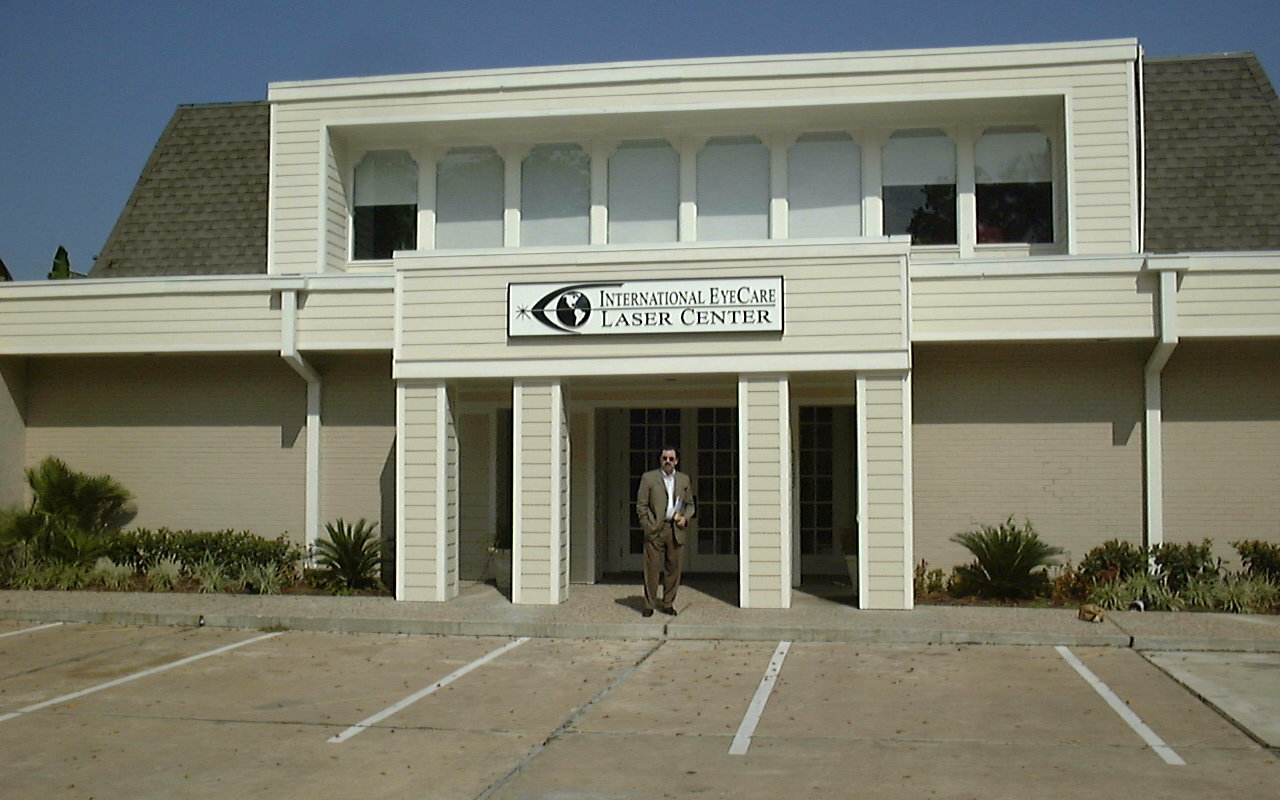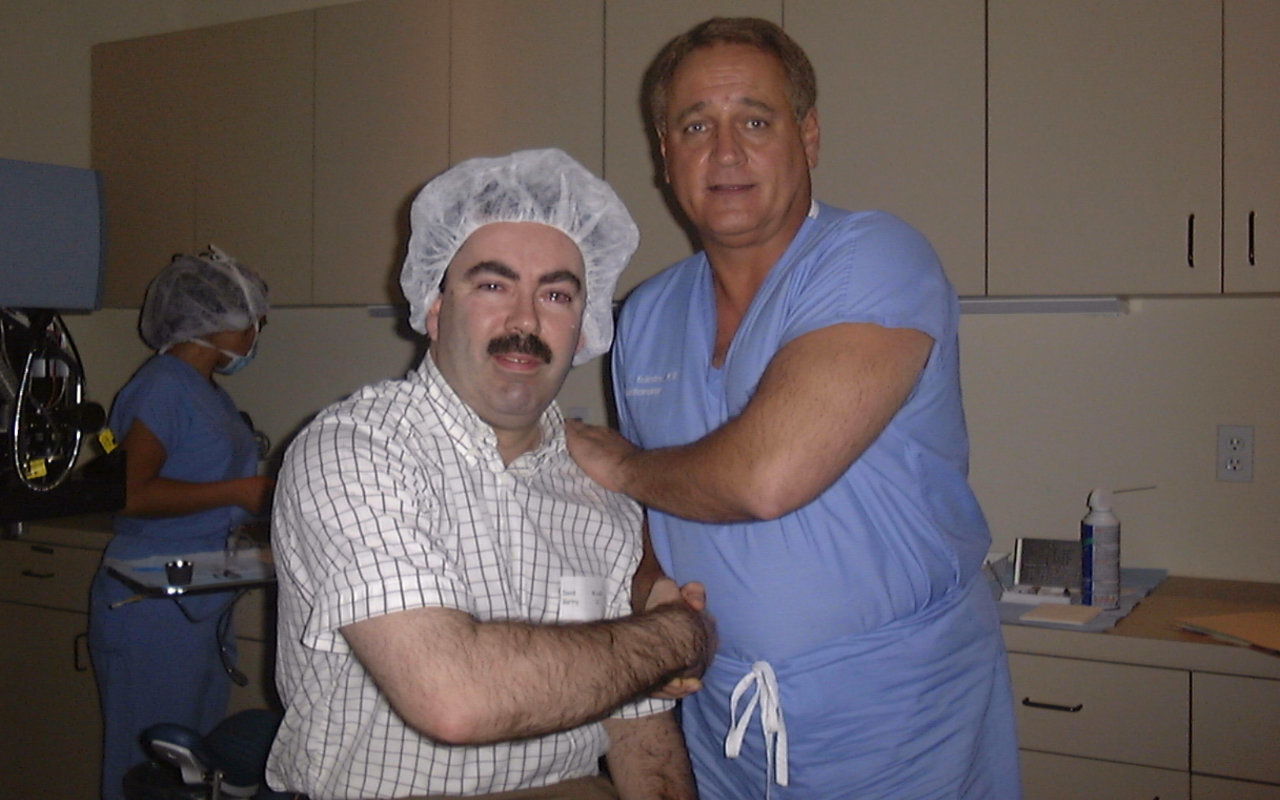020 7490 7222 Book an appointment
We sat down with David Gartry to hear about his own laser eye surgery journey.
Where and When did you have your laser vision correction?
I had my LASIK treatment in Houston in the US in October 2000 and it was carried out by a surgeon called Jack Holladay who’s a friend and colleague of mine and a very well-known American Ophthalmologist. I had invited Jack to speak at our annual meeting at the BSRS (British Society of Refractive Surgery) in the summer of 2000. He gave a lecture on using laser technology for correcting astigmatism which at that time was more difficult. He takes laser calculations and programming very seriously indeed and advised me that he thought the technology had advanced enough to treat my degree of astigmatism. I had been invited to speak at the AAO meeting (American Academy of Ophthalmology) in Dallas later that year so the timing worked out well, allowing me to have my treatment with him in Houston. I think I’m right in saying that at the time, back in October 2000, I was the first ophthalmic surgeon in the UK to undergo laser refractive surgery.

David Gartry at the International EyeCare Laser Center, Houston, Texas, 2000
What was your prescription?
I had a moderate amount of short-sightedness, approximately -2.50 to -3.00 units, but I also had about 3 units of astigmatism so, if you combine the two sets of numbers, it comes to approximately -5.00 to -6.00. But we know that astigmatism is more difficult to treat so if someone has a moderately high prescription but very little astigmatism that’s often easier to treat than someone like myself who has a more medium amount of short-sight and high astigmatism. Astigmatism is also difficult to correct with contact lenses for that matter because the extra dimension with astigmatism is an angle or an axis in the prescription which means the contact lenses have to be at just the right angle. If they move or rotate around when you blink then suddenly the astigmatism is not being fully corrected. It’s exactly the same with laser refractive surgery. We have to make sure that the angle of the astigmatism is perfectly aligned with the laser. We achieve this by doing very careful preoperative scanning and using software which includes Iris Recognition so that when the laser treatment is being applied to the cornea it’s at absolutely the right angle.
Being a very experienced refractive surgeon yourself were you particularly nervous before your treatment?
I wasn’t really. What was interesting was that Jack (Holladay) insisted at the time that all of his patients should have a mild sedation so his assistant came to give me a Valium and I said ‘Oh no thank you, I don’t need it, I know all about it’.
I sat in a nice semi-darkened room listening to classical music in a big chair along with several other patients before I was called through. I’ve never really been nervous about having medical procedures carried out. I’m not wonderful with the dentist but I manage ok! When it comes to any type of medical procedure friends and colleagues would say that I’ve been fairly tolerant. As I’d been involved with laser eye surgery from the very beginning, and I’d already seen it work so well for thousands of patients, I fully expected that I would get a good result. I’ve now done over 22,000 treatments and in October 2000 I must have done about 5,000 or 6,000 treatments. So all in all I wasn’t nervous.
How did your treatment actually feel?
Bearing in mind that I had the microkeratome version, which uses a bit more pressure on the eye than we use nowadays, it wasn’t difficult to tolerate. The worst part about it is the pressure whilst the flap is being created which lasts for about 20 – 30 seconds per eye and feels like you’re pressing on your cheek quite firmly. Once you’re through that the rest is very straightforward.
I obviously knew what to expect, which helped, but I always explain to patients what is happening at each stage of their treatment. Patients respond very well to this as it helps them stay calm and they appreciate it afterwards. You can see this in the feedback patients give us on our website.

David Gartry undergoing LASIK treatment, October 2000
And the results of your treatment?
The results have been outstanding. Given that I had a more difficult moderately high prescription with astigmatism I had expected some prescription to be left behind. The result in my left eye turned out to be absolutely perfect and I achieve the standard of vision required by the Royal Air Force Pilots, which is excellent given the complexity of the prescription. My right eye has a very small amount of short-sight left behind, (approximately -0.50 dioptres) which doesn’t sound very much but it’s actually very helpful for reading. So my left eye is very clear for distance and while my right eye is also good for distance it’s actually slightly better for reading computer screens and phones. So overall I’ve actually done extremely well. It wasn’t the intention to make one eye slightly short-sighted but we now know that it’s possible to achieve reasonable reading vision by deliberately making one eye slightly more short-sighted than the other, a technique termed ‘mini-monovision’. There were no side-effects at the time and as is normally the case my vision settled after 2 or 3 months to what it is today almost 17 years later. I’ve enjoyed excellent distance vision in all that time. I don’t have the need for any form of correction for distance or intermediate vision but I do possess a pair of reading spectacles which I keep in reserve for when the lighting isn’t very good. This is normal as I’m now over 40! Overall I couldn’t have asked for a better result – thanks to Jack Holladay.
What has changed in the technology since you had your treatment?
I had my astigmatic short-sighted LASIK treatment done with a microkeratome, which is a more basic instrument which was used at the time for making the corneal flaps. About 5 years later, around 10 years ago now, we began to use femtosecond laser technology to create the flaps instead. Using a laser to create the corneal flap is much more accurate. While some innovations may take longer to be accepted, it was obvious that femtosecond laser technology was going to be an instant success. Colleagues here at Moorfields who started to use it gave up using the microkeratome within 2 or 3 weeks! That doesn’t normally happen as there’s usually a period of overlap where some early adopters decide to use the new technology while others wait a year or two to evaluate the results. Using a femtosecond laser to make the flap was what we now call a ‘no-brainer’ and it very quickly became adopted around the world by eye surgeons. There may well be some centres still using the microkeratome to create the corneal flap but I think they are absolutely in a minority.
The other thing that’s changed since 2000 is the introduction of wavefront technology. I had my own treatment just before the wavefront era. Wavefront aberrometry is essentially a way of measuring the optics of the eye very accurately so that we can obtain a very precise assessment of the exact prescription. It also takes a photograph of the front of the eye when the patient is in clinic and this photograph is then analysed by the laser at the time of treatment. It’s a bit like the iris recognition software at Heathrow airport where you can have your irises scanned instead of going through normal passport control. With iris recognition you can’t treat the wrong patient or the wrong eye because the laser recognises exactly which eye you’re supposed to be treating. Furthermore, with regard to the astigmatism axis, it can actually line the treatment up very carefully with the centre of the pupil and the astigmatism so if the patient moves slightly the laser will follow this movement and dynamically track the eye. The patient would have to move their eyes a considerable amount for the laser to stop. So since I’ve had my treatment astigmatism results have improved quite considerably.
With regards to changes in the future I think we’ve now reached a plateau with laser to a large extent. Improvements happening now tend to be quite minor as you might expect after 28 years. We’re getting to that point where there are tiny improvements but no huge quantum leaps. I think if anything comes along in the future which is better than laser refractive surgery it would have to be something completely different.

David Gartry immediately after his LASIK treatment with Dr Jack Holladay
Have any of your friends or family had the treatment since you had yours done?
Yes. I actually treated my wife 4 years after I had my own treatment. I’ve also treated colleagues’ wives, husbands and families, nursing staff and others here at Moorfields which is always very nice because it means that people who know what happens behind the scenes have recommended you to one of their family members. It’s a big accolade for any surgeon.
Speaking as a patient, what advice would you give patients who are considering having laser eye surgery?
In a single sentence I would say: read about it and research it as much as possible. You may also be able to talk to friends or family who have had it done themselves, which is very useful of course, but you do need to research it properly yourself. Sometimes patients are too frightened to look into it carefully, however careful research is very important. I insist that my patients read all the information we give them, which complements the information on our website as well. I would certainly endorse researching it carefully and then making your own personal decision.
If you would like to book a consultation with David Gartry please get in touch – we look forward to hearing from you.